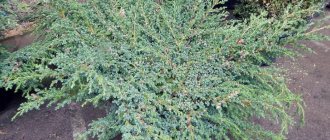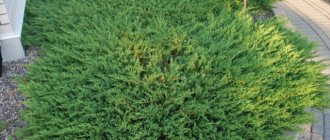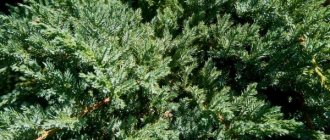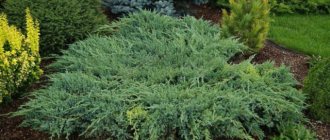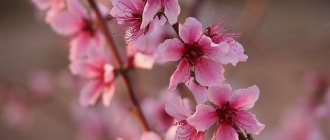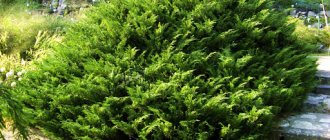Decorative conifers, popular among gardeners, add a graphic touch to the garden and remain attractive all year round. As part of plant compositions of any style, there is a place for prickly beauties. Among the variety of coniferous plant species, one can highlight the juniper variety - Blue Star. Its compact shape fits perfectly into a small flower bed, and the unusual color of the pine needles attracts the eye.
Description of juniper Blue Star
This is a low-growing shrub that grows several centimeters per year. Its numerous shoots are densely strewn with short, prickly needles. Young seedlings up to a year are spherical in shape, while an adult plant takes on the shape of a hemisphere or dome. Does not require additional shaping pruning. In spring and summer, juniper spines are smoky-gray and blue; in autumn and winter they turn purple.
A grown shrub with scaly, colored needles will become a wonderful decoration of the landscape. Possessing excellent decorative qualities, blue star juniper exudes a strong pine aroma. Its essential oil is believed to have phytoncidal and disinfectant properties.
Dimensions of juniper BlueStar
This plant is compact: the height of blue star juniper is no more than 70 cm, the diameter of the crown does not exceed 1.5 m. This species is classified as dwarf. The small size of the shrub is compensated by the density of the needles and the close arrangement of the branches; they form a lush crown.
Winter hardiness zone of juniper scaly Blue Star
The plant is considered winter-hardy. Recommended for cultivation in central Russia. In northern regions it requires shelter for the winter. It tolerates frost well under snow. Shrubs of the first year are covered for the winter even in the southern regions.
Annual growth of Blue Star juniper
This variety is slow growing, after planting, after 10 years its height will be only 50-70 cm, crown circumference - no more than 1.5 m. Juniper grows in height up to 5 cm per year, shoots add 10 cm in 12 months.
Is Blue Star juniper poisonous or not?
The plant is classified as a poisonous crop. When carrying out gardening work: pruning, fertilizing, watering, you must wear gloves. It is important to protect children and pets from contact with Blue Star juniper squamata.
Important! Shrub cones in the form of berries, which contain a large amount of toxic substances, are also dangerous.
Rock juniper (Juniperus scopulorum)
The species grows in nature on the slopes of the Rocky Mountains of North America at an altitude of 2000 m above sea level. Tree, usually multi-trunked. The needles are dark green, mostly scale-like, needle-shaped, up to 12 mm long. The round cones are dark blue with a bluish tinge.
Rock juniper Blue Arrow
A narrow-columnar shrub with a dense crown, up to 2 m high at 10 years of age. The needles are bluish-gray and scaly.
Rock juniper Blue Arrow
Rock juniper Blue Heaven
Shrub up to 2–2.5 m high and up to 1.5 m in diameter, with a uniform conical crown. The needles are bluish-green.
Rock juniper Blue Heaven
Rock juniper Moonglow
Shrub up to 3–5 m high and up to 1 m in diameter. The needles are silver-blue. There is a variegated variant, Moonglow Variegated, with a creamy white color.
Rock juniper Moonglow
Juniperus rocky Skyrocket (Sky Rocket)
Popular variety. A narrow columnar shrub, up to 6 m high (2.5 m at 10 years of age) and up to 0.8–1 m in diameter. The needles are grayish-blue.
Juniperus rocky Skyrocket (Sky Rocket)
Juniper Blue Star in landscape design
The lush branches of the bush allow you to create original compositions using it. The gray-blue shade of the needles looks advantageous against the background of other evergreen coniferous and deciduous crops.
This plant will fit well into the design of rockeries, rock gardens, and home lawns. Thanks to its compact size, Blue Star can be grown in pots and cache-pots, which will become a wonderful decoration for street window sills, balconies, and canopies.
In open areas and hillocks, low-growing varieties of juniper are used in combination with other creeping, rocky plants.
In the photo you can see how good several types of juniper look, including scaly Blue Sky, framing stone and brick buildings and stairs.
If you wish, you can grow or purchase bluestar juniper bonsai. This is a miniature, exotic, ornamental plant that can be used to decorate any design, not just outdoors. Bonsai is indispensable for landscaping loggias, roofs, terraces, and balconies. With its help you can create miniature landscape compositions in winter gardens and home premises.
This shrub is grown from seeds or cuttings. The seeds are obtained from dried and crushed juniper fruits. Cuttings are taken from a young plant whose bark has not yet become woody or brown. It is important to take into account that the germination of juniper seeds is weak, so you need to prepare a lot of them.
Blue junipers: noble, but not capricious
Junipers, whose name contains the English word blue (translated as blue), have needles of a beautiful blue hue. In the garden, such plants are most often used as ground cover due to their creeping crown. With its noble beauty, blue juniper sets off green coniferous plants and deciduous shrubs. White flowers of lilac, hydrangea, cinquefoil, and mock orange will add solemnity and pomp to the composition. For vertical accents, medium-sized plants with columnar or pyramidal shapes are selected. Below you will find descriptions of varieties and characteristics and brief information on how planting and care are carried out for each variety.
Planting and caring for Blue Star juniper
To root the crop, choose open areas well lit by sunlight. In the shade of buildings and tall plants, juniper becomes faded and loses its needles. In the absence of ultraviolet light, the Blue Star becomes similar to an ordinary wild juniper with pale green needles. For this ornamental crop, it is also important that the area is well ventilated.
Important! The proximity of groundwater is undesirable for the shrub; this can lead to its death. Also, saline soils that lack drainage are not suitable for planting Blue Star.
Preparing seedlings and planting area
Blue Star juniper grows well and takes root on soils with any composition, except salty and overly moist ones. If the site is dominated by clay soils, the plant must be provided with high-quality drainage. You can also mix the soil with sand and peat in equal parts. Humus and clay are added to sandy and rocky soils.
Before rooting into the planting hole, seedlings must be in special pots or containers, the roots are protected and moistened. Before planting, the plant must be carefully removed from such a container.
Rules for planting juniper Blue Star
Blue Star juniper seedlings are planted in the spring. In order for them to grow well, it is necessary to maintain a distance of at least half a meter between several plants. Ideally, so that the shoots can stretch freely, when planting in groups, the distance between planting holes is 2.5 m.
Landing algorithm:
- First of all, dig a planting hole the size of which is larger than the rhizome.
- A layer of approximately 10-15 cm of pebbles or expanded clay is laid on the bottom. This material will serve as drainage.
- The next layer, at least 10 cm, is fertile, fluffy soil with the addition of peat and sand.
- The seedling is removed from the container along with a lump of earth, while the roots should not be damaged.
- After Blue Star is lowered into the planting hole, the roots are straightened. It is important to monitor the root collar: it should be above the ground or level with it.
- Sprinkle the juniper roots with a mixture of soil, sand and peat, taking them equally.
After planting, the plant is watered abundantly and the soil is mulched. A week after rooting, stop watering and add another small layer of soil under the soil.
Watering and fertilizing
Juniper juniperus squamata blue star needs watering only in summer, when there is no precipitation. 3 waterings per season are enough. Approximately a bucket of water is allocated for one bush. If the high temperature lasts for more than a month, the juniper needs spraying. The procedure is carried out in the evening, after sunset, once a week. If the climate zone where Blue Star grows receives sufficient summer precipitation, additional watering is not necessary. Excess moisture is detrimental to the Blue Star.
Fertilizer is applied to the soil in early spring, during the period of swelling of the buds. The soil is dug up with nitroammophos, about 15 cm away from the trunk, and then watered with Blue Star. In October you can also dig up soil with potash fertilizers.
Juniper over 2 years old does not need feeding. Growing on fertile soils saturated with microelements, the Blue Star loses its rounded crown shape, the shoots grow and lengthen. An adult Blue Star plant only needs watering, removing weeds and loosening the soil.
Mulching and loosening
Juniper grows actively if there is air access to its roots. To do this, 2-3 times during the summer you need to carefully dig up the soil around the trunk of the bush.
It is important to regularly remove all weeds; pests can grow in their leaves. Afterwards, the soil can be sprinkled with complex fertilizer for coniferous crops and watered. Then the soil is mulched with wood chips, sawdust, and peat.
Important! Mulch prevents the germination of weeds and drying out of the soil. If you mix the mulch layer with fertilizers several times a season, there is no need for additional fertilizing.
Cutting juniper Blue Star
In the fall, sanitary pruning of bushes is carried out. Remove dead, dry, damaged branches. During the procedure, attention is paid to parasites and diseases that can affect the plant. If there are signs of larvae or spotting, the damaged branches are removed and burned, and the bush is treated with special chemicals.
Blue star juniper does not need formative pruning. It acquires a rounded crown shape as it grows.
Preparing for winter
In late autumn, when the garden is being dug up, the soil around the juniper is also loosened. Afterwards it is covered with a 10-centimeter layer of peat to insulate the roots. The shoots are tied with loose rope or tape so that they can withstand the weight of the snow. Afterwards spruce branches are thrown over the bush to protect it from frost.
Important! In spring, the spruce cover is not removed before the end of April, since the first spring rays can burn the tender juniper needles.
Watering mode and frost protection
In arid regions or in the absence of natural precipitation in the summer heat, juniper must be watered several times a season. This is especially true for a small young plant or a recently transplanted bush. But even in these cases, excess moisture and its stagnation are unfavorable factors for juniper.
The amount of water per watering should not exceed 10-30 liters, depending on the size of the plant. During the hottest and driest seasons, it is enough to water the blue star once every 2-3 weeks and after 5-7 days, sprinkle the crown (after sunset). If rainfall is abundant and regular, then artificial irrigation may not be necessary at all.
In regions with frosts of more than -25°C, with insufficient snow cover, or in years when there is little snow at the beginning of winter, but the temperature drops below the specified values, juniper may freeze. This will be noticeable only in the spring, when some of its branches dry out and acquire a brown tint. If the damage is small, only the decorative appearance of the bush will suffer, and the dried branches will have to be cut out. But for a small young juniper, severe frosting can be fatal. Therefore, after frost sets in in October-November in the northern regions, it is better to cover such plants with non-fabric or spruce branches. In early spring, the covering material must be removed to prevent damping off of the plant.
An unpretentious plant that quickly recovers from damage can become a real decoration of the garden. For many years, juniper scaly blue star can grow in one place without interfering with neighboring bushes.
Reproduction of juniper Blue Star
This crop can be propagated by layering, seeds and cuttings. The seeds produce non-viable seedlings with weak decorative characteristics.
Cuttings can be obtained from an adult plant that is at least 5 years old. At the end of April or early May, strong branches with buds are selected. They are cut and divided into small pieces of approximately 15 cm. Then they are placed in a growth stimulator for a day. Afterwards the branch is rooted in a mixture of peat and sand. As soon as the roots appear, the seedlings are transferred to the garden plot.
Shrubs are often propagated by layering. They are secured with staples to the ground in several places. As soon as the roots appear, young Blue Star juniper plants are transplanted.
Description and main features
This is far from a fast-growing plant.
It grows to a height of no more than 5-8 cm per year. When the plant becomes an adult, it can reach half a meter to a meter in height and about one and a half to two meters in diameter. It has short and fairly prickly needles. It has a silvery, greenish-blue tint. And its young shoots can be turquoise and even grayish.
Over time, mature branches acquire a calmer tone, although the general appearance of the shrub remains quite exotic.
It is not for nothing that juniper squamata is called the beautiful name blue star, understanding this association as a beautiful luminary against the backdrop of the natural atmosphere. Therefore, in landscape design, experts prefer to turn to blue star juniper, thanks to which it is not difficult to create original compositions: the spreading branches of the bush help with this.
The unique blue color of its crown allows it to contrast with other garden plantings. This also makes juniper an excellent decoration for the following landscape elements:
- rocky slopes,
- rock gardens,
- open loggias and terraces,
- as well as for personal plots, garden compositions, lawns, and in some cases even balconies.
Hedges containing this shrub in their composition have a special charm.
A personal plot decorated with plantings with the participation of other junipers and interspersed with small stone mounds can become an evergreen and beautiful natural corner, capable of impressing the most whimsical connoisseur with its picturesqueness.
It is thanks to the rare and unique blue star color in nature, which arises from a bizarre combination of young and adult shoots, that it gives that unique effect that gave this culture its exotic, rare name.
Pests and diseases of Blue Star juniper
All varieties of junipers suffer from rust. It affects the branches, red spots appear, and the bark in this area dries out and cracks. Damaged shoots are cut off and destroyed, and the bush is treated with special preparations.
In spring, fungal infections can be found on juniper needles. At the same time, the needles turn yellow and fall off. The shrub is sprayed with fungicides once every 7 days until the signs of the disease completely disappear.
Juniper Blue Star can be affected by scale insects, aphids, mites, and moths. As soon as their larvae appear on the shoots, the bushes are treated with insecticides until the pests are completely destroyed.
Important! If the treatment is carried out at the first signs of damage, the decorative qualities of the shrub will not be affected.
The appearance of pests and diseases of Blue Star juniper is not associated with care. Infection can occur from nearby garden crops.
Description of the variety
The plant belongs to the genus Juniperus, the Latin name is Juniperus squamata Blue Star, in Russian the name of the juniper is Blue Star. This is one of the most beautiful dwarf, slow-growing varieties of this type of conifer.
The variety has been known to gardeners since the mid-20th century; its origins are in the Netherlands. Blue star juniper forms a creeping shrub, about half a meter high. The crown grows in width to a diameter of 150-170 cm.
The needles are silver-blue (to turquoise), the needles are wide and short. They densely cover the branches of the plant, creating the effect of fluffy paws.
In autumn, juniper berries ripen, which are poisonous!
The peculiarity of this variety of ephedra is its slow growth. The annual growth rate, under favorable conditions, is no more than 8 cm.
The frost resistance of the plant is good; in most regions of our country it does not require shelter.
